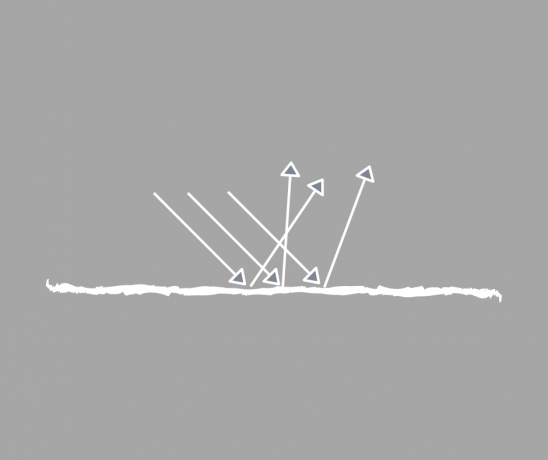Light reflection happens when a beam of light strikes a surface and returns to the source medium. It is thanks to the reflection of light that we are able to see objects, as light, when emitted from a light source, falls on the objects and returns to its original environment, until it meets our eyes.
The mirror is the main example of light reflection, however, this phenomenon occurs on almost all surfaces.

Image of a diffuse reflection on the surface of the water.
Types of reflection
The reflection can be diffuse or even, which will be determined by the type of surface where the light falls. Understand:
diffuse reflection
When the surface is rough or irregular, the light beams arrive parallel and after hitting the material, are reflected in various directions - allowing us to see objects from different angles. We can see objects because they reflect the light that falls on them and this light reaches our eyes.
Diffuse reflection occurs on surfaces that are not smooth like a mirror, but reflect light, such as sheet metal or moving water. Most metals have roughness on their surface, so the image reflected by it is not as sharp as in a mirror.

regular reflection
Regular reflection occurs when a beam of light hits a smooth or polished surface - this is the case with mirrors or standing water. In this case, the incident light rays reach the surface and are reflected equally in a parallel way.
As the rays are emitted in only one direction, the image reflected by the mirror can only be seen if the observer is facing the reflected rays. If you stand next to a flat mirror, you might not see your image reflected in it.

Mirror
Although light reflection occurs on practically all surfaces, the mirror is the best example to explain this phenomenon. Most of the time, the light that falls on the mirror is reflected evenly.
Furthermore, the mirror reflects all the colors that fall on it and that is why the images reflected by a mirror are so perfect. When the reflection takes place on a material other than the mirror, the surface reflects certain colors, but absorbs others.
Laws of reflection
Physics explains the reflection of light in terms of two laws. To understand both laws it is necessary to know the elements that explain the phenomenon. Look at the image:

Image:
Incident ray - is the beam of light that reaches the surface
Reflected ray - is the beam of light that hit the surface and was reflected
N - normal straight, perpendicular to the surface.
î - incidence angle
r - reflection angle
1st Law of Reflection
The incident ray, the reflected ray and the normal line are coplanar, that is, they are in the same plane.
2nd Law of Reflection
The angle of incidence (î) is always equal to the angle of reflection (r ) with respect to the normal line.
light refraction
In addition to reflection, another optical phenomenon that has been well studied is the refraction of light. Refraction occurs when light changes its propagation medium, for example, from air to water. In this change, the speed of light changes and as a consequence the light undergoes a deviation in its propagation.
That's why when we put a brush into a glass of water, we get the impression that it's broken, as shown in the image.

See also the meaning of optics and light-year.



